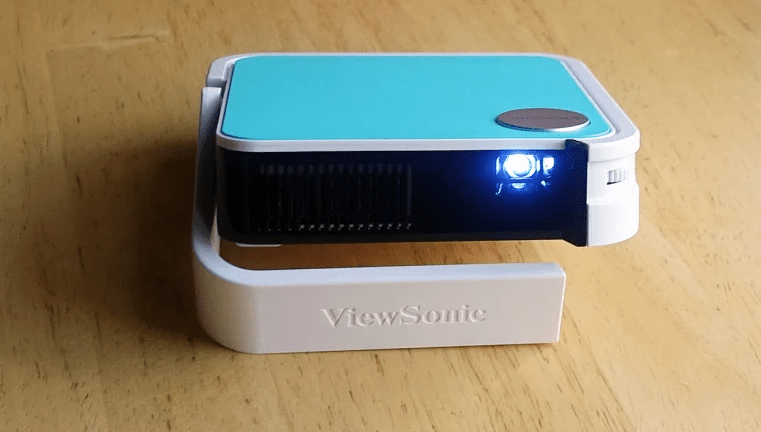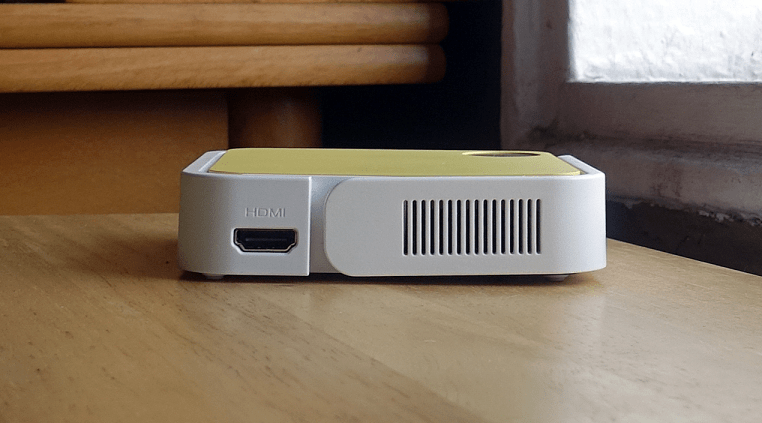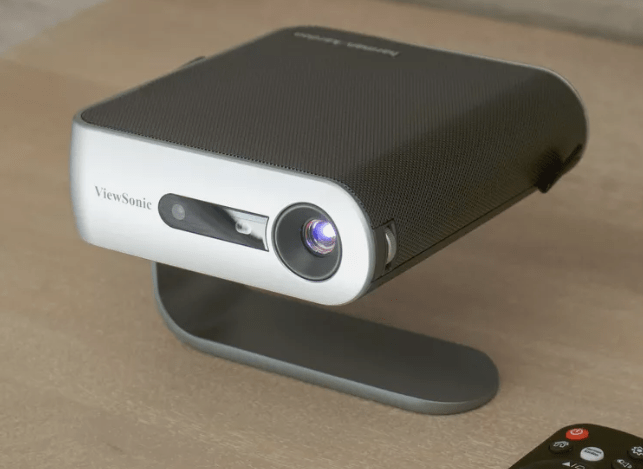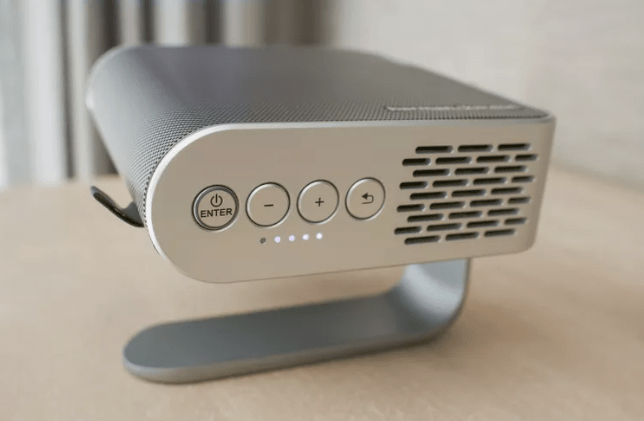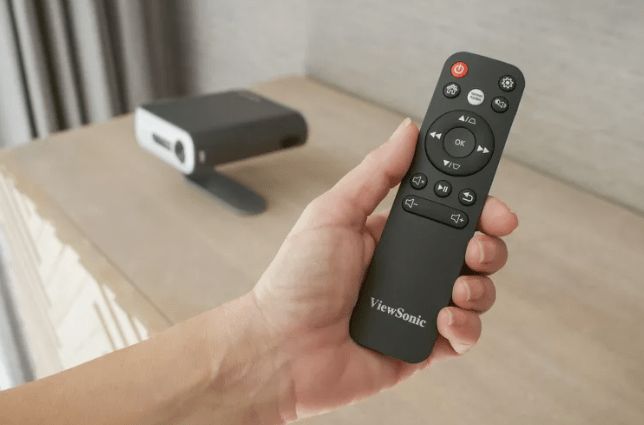At gagadget.com, your trust is our priority. We follow strict quality standards in our research, tests, and analysis of video projectors, to give you the best experience. Learn more
Viewsonic M1 Mini vs Viewsonic M1+: Comparison
Hey everyone, Jim's here. Today I'm pitting two ultra-portable LED projectors from Viewsonic against each other: the pocket-sized M1 Mini and the slightly larger M1+. Both pack a lot of convenient entertainment into impressively compact designs. But there are some key differences in brightness, audio, and smart features that could sway you one way or the other.
I've spent quality hands-on time with both the M1 Mini and M1+, evaluating image quality, ease of use, portability, and overall practicality. In this head-to-head comparison, I'll break down how they stack up to help you decide which one best suits your on-the-go viewing needs. Let's dive in!

Viewsonic M1 Mini vs M1+: Quick Overview
I respect your time and aim to provide only the essential information, skipping the fluff.
If you're in a hurry, here's my quick take: The Viewsonic M1 Mini and M1+ are both extremely compact LED projectors ideal for impromptu viewing on the go. They share the same 854x480 WVGA native resolution, 120,000:1 dynamic contrast ratio, and 30,000-hour LED lifespan. The main differences are that the M1+ is twice as bright at 300 LED lumens vs 120 for the M1 Mini, and it features dual Harman Kardon speakers plus wireless streaming capabilities.
For most users, I recommend the Viewsonic M1+. The higher brightness, better audio, and smart wireless features make it more versatile and immersive for all-purpose mobile entertainment. But if you absolutely need the smallest form factor possible and can live with lower volume and wired sources only, the M1 Mini is an incredibly portable and affordable option.
Table of Contents
- Viewsonic M1 Mini vs Viewsonic M1+: Full Comparison
- Viewsonic M1+ vs M1 Mini: Design
- M1 Mini or M1+: User Reviews
- Viewsonic M1 Mini and M1+ Alternatives
- Which Portable Projector is Best for You, Mini or M1+?
Viewsonic M1 Mini vs Viewsonic M1+: Full Comparison
| Specs | Viewsonic M1 Mini | Viewsonic M1+ |
| Image |
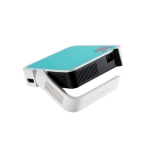
|
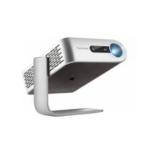
|
| Native Resolution | 854 x 480 (WVGA) | 854 x 480 (WVGA) |
| Brightness | 50 ANSI lumens / 120 LED lumens | 300 LED lumens |
| Dynamic Contrast | 120,000:1 | 120,000:1 |
| Display Tech | 0.2-inch DLP | 0.2-inch DLP |
| Input Lag (1080p/60Hz) | 33ms | 33ms |
| LED Lifespan | 30,000 hours | 30,000 hours |
| Throw Ratio | 1.23:1 | 1.20:1 |
| Keystone Correction | Vertical only | Vertical only |
| 3D Support | Full HD 3D | Full HD 3D |
| Built-in Speakers | 2W mono (JBL) | 3W x 2 stereo (Harman Kardon) |
| Wireless Connectivity | None | Wi-Fi, Bluetooth, screen mirroring |
| Dimensions (W x D x H) | 4.3" x 4" x 1.1" | 5.8" x 5.2" x 1.6" |
| Weight | 0.67 lbs | 1.54 lbs |
| Year | 2019 | 2019 |
Right off the bat, the defining feature of these projectors is their incredibly small size. I've tested a lot of portable and pico projectors over the years, but the Viewsonic M1 Mini is easily one of the most compact I've ever seen. Measuring just 4.3 x 4 x 1.1 inches and weighing under 11 ounces, it's roughly the size of a thick smartphone. This tiny form factor makes it ideal for impromptu movie nights, presentations on the go, or keeping the kids entertained in the car. You can literally slip it in a pocket and have a big screen experience anywhere.
The M1+, while still very portable, is about twice the size and weight of the M1 Mini. It tips the scales at 1.54 pounds and measures 5.8 x 5.2 x 1.6 inches. Still easy to toss in a bag, but not quite as discreet or pocketable. The tradeoff is that the M1+ packs in some notable upgrades, which I'll get to shortly.
When it comes to core image specs, the two projectors are evenly matched. Both use a 0.2-inch DLP chip with WVGA (854x480) resolution, good for about a 480p picture or roughly DVD quality. This is par for the course with projectors this size - you're not going to get full HD or 4K at this scale. But I found the image to be reasonably sharp and colorful on screens up to about 60-70 inches.
Brightness is the first major difference. The M1+ pumps out 300 LED lumens compared to the M1 Mini's 120 lumens. In real-world terms, this means the M1+ can power a larger image in rooms with more ambient light. I was able to get a quite watchable 70-80 inch picture with moderate indoor lighting, whereas the M1 Mini struggled to produce a clear image much beyond 40-50 inches unless the room was fully dark.
Both models claim a 120,000:1 dynamic contrast ratio, which is impressive for this class. In practice, I found black levels and shadow detail to be decent but not mind-blowing. You're not going to get inky OLED-like blacks from projectors this size. But both did an admirable job preserving details in darker scenes from Game of Thrones and The Mandalorian.
Another big upgrade on the M1+ is audio. It features dual 3-watt Harman Kardon speakers vs a single 2-watt JBL speaker on the Mini. The difference is immediately noticeable - the M1+ gets much louder and produces legitimate stereo separation for a more immersive soundstage. It won't rattle any windows but it's a clear step up from the M1 Mini's smaller mono driver. For casual viewing and YouTube clips, the M1+ speakers are quite satisfying.
Both support Full HD 3D content and offer a very respectable 33ms input lag for gaming. I hooked up my Nintendo Switch and had a blast playing Mario Kart and Smash Bros. on a big screen with no perceptible delay. Obviously you're limited to 480p resolution, but most Switch games still look great and the added image size really draws you in.
The other key advantage of the M1+ is wireless connectivity. It has Wi-Fi and Bluetooth built in for easy streaming from phones, tablets, and computers. It also supports screen mirroring for compatible devices. The M1 Mini, by contrast, is wired-only. You'll need to connect your sources via HDMI, or load media files onto a USB drive or microSD card. Not a huge issue, but the M1+'s wireless options are a nice convenience.
Viewsonic M1+ vs M1 Mini: Design
Design-wise, the two projectors share a similar aesthetic with minor differences. Both have a sleek rectangular shape with rounded edges and a matte white finish. The main distinction is size - the M1 Mini is almost comically small, while the M1+ is about twice as large in every dimension.
Viewsonic M1 Mini Design:
Viewsonic M1+ Design:
Both feature a clever integrated "smart stand" that doubles as a lens cover. When closed, it protects the lens from scratches and dust. When opened, it props the projector up at a fixed angle and automatically powers on the unit. This allows for super quick setup and pack-up - no fiddling with a separate stand or waiting for the projector to boot.
Around back, you'll find a minimal set of ports. The M1 Mini has a single HDMI 1.4 input, USB Type-A reader, and a small DC power jack. The M1+ adds a 3.5mm audio output, a second USB port, and swaps the DC jack for a more modern USB-C power input. Both can be charged via portable battery packs for truly wire-free use.
Controls are also very basic. The M1 Mini has touch-sensitive buttons on the top for power, volume, and menu navigation. The M1+ moves these to the side and makes them physical buttons for easier use in the dark. Both come with credit card-sized remotes that get the job done but feel a bit cheap.
M1 Mini or M1+: User Reviews
So what are actual owners saying about their experiences with the Viewsonic M1 Mini and M1+? Here are some common themes from online reviews:
Viewsonic M1 Mini Owner Impressions:
Praises: "The size and portability of this projector is insane. I can literally carry it in my pocket and instantly stream movies anywhere. Great for camping trips!"
"Image quality is surprisingly good for such a tiny projector. Obviously it's not HD but it's sharp enough and the colors are quite vibrant."
***
Drawbacks: "The brightness is fairly low, so you really need a pitch black room to get a halfway decent image much larger than 40 inches. Don't expect to use this in daylight."
"The built-in speaker is tinny and anemic. Fine for a quick YouTube clip but for movies you'll definitely want to connect an external speaker."
Viewsonic M1+ Owner Impressions:
Praises: "The portability and ease of use on this projector is fantastic. I love being able to quickly set it up for movie nights or gaming sessions with zero hassle."
"I'm really impressed by the built-in Harman Kardon speakers. They get nice and loud and actually provide decent stereo separation. Perfect for casual viewing."
***
Drawbacks: "Wireless screen mirroring is pretty hit or miss, especially with Apple devices. I often have to fiddle with the connection to get it working smoothly."
"480p resolution is pretty low by modern standards. It's fine for kids' movies and YouTube videos but don't expect razor-sharp Blu-ray quality here."
Overall, M1 Mini owners adore the projector's extremely compact size and acceptable 480p image for on-the-go use. Many praise it as the ultimate portable movie machine. The main complaints are the low brightness and weak built-in audio.
M1+ buyers appreciate the step up in brightness, speaker quality, and wireless connectivity. The Harman Kardon drivers and extra lumens make it a more compelling TV alternative. A few users encountered hiccups with screen mirroring and wished for 720p or 1080p resolution.
Viewsonic M1 Mini and M1+ Alternatives
If you're not totally sold on either Viewsonic model, here are a couple other highly portable LED projectors worth a look:
- AAXA P6X: This slightly larger portable projector offers 1280x800 native resolution, 1000 LED lumens, a 15,000mAh battery, and onboard Android OS with streaming apps. A versatile step up in image quality;
- Anker Nebula Capsule II: A soda can-sized 720p DLP projector with Android TV 9.0, 200 ANSI lumens, 8W speaker, and auto focus. Pricey but very slick and user-friendly.
The AAXA P6X is a compelling choice if you can sacrifice a bit of portability for a sharper, brighter image. The 1280x800 resolution and 1000 lumens are a huge upgrade over the 480p Viewsonics. It also has Android with Netflix and YouTube preloaded. But it's significantly larger than even the M1+.
For a more refined all-in-one experience, it's hard to beat the Anker Nebula Capsule II. The 720p resolution, auto focus, and integrated Android TV make it a joy to use. 200 ANSI lumens is almost as bright as the M1+. The cylindrical design is supremely portable. Just be prepared to pay a premium for the extra polish.
Which Portable Projector is Best for You, Mini or M1+?
After extensive hands-on testing, it's clear the Viewsonic M1 Mini vs Viewsonic M1+ are two of the most portable and user-friendly projectors on the market. With their tiny footprints, quick setup, and acceptable 480p image quality, they're fantastic options for on-the-go entertainment. You'll be shocked how much big screen fun you can squeeze into such small packages.
That said, there are some notable differences. The M1 Mini's primary draw is its absurdly compact size. If you need a projector that fits in your pocket, this is it. It's the ultimate grab-and-go movie machine, even if the brightness and audio are mediocre.
The M1+, on the other hand, justifies its larger dimensions with some key upgrades. The 300 lumens and dual HK speakers provide a more engaging and flexible viewing experience. It's easier to play with friends or use in rooms with some ambient light. The wireless connectivity is also a big plus for streaming.
Ultimately, I recommend the M1+ for most people. The brightness, audio, and wireless benefits are well worth the extra size and cost in my book. It's simply more pleasant and versatile to use, both at home and on the move. Get the M1 Mini if maximum portability is your number one priority.
Whichever one you choose, prepare to be amazed by the convenience of having a legitimately good projector in your pocket or bag at all times. From impromptu movie nights to gaming sessions to business presentations, these little marvels put a whole new spin on portable entertainment. Your phone or tablet screen will never feel adequate again!
Go Deeper:
